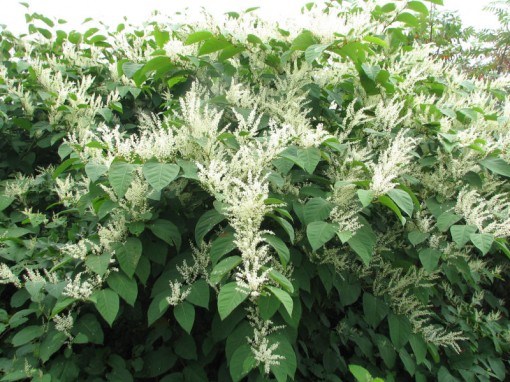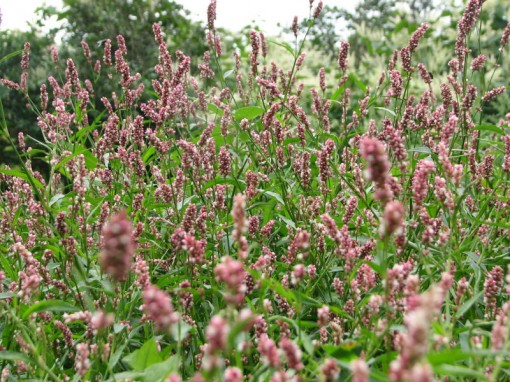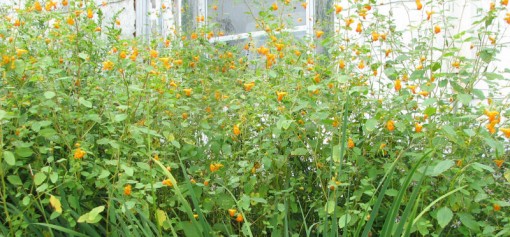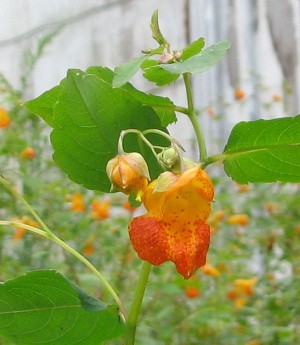
Isn’t this a stunning specimen of Polygonum cuspidatum? The generous rainfall we’ve had this season has brought it into top form. Too bad it’s on America’s Most Wanted list. Yes, this is Japanese knotweed, aka Japanese bamboo, Mexican bamboo, fleeceflower, and Fallopia japonica. (I’ve been told that it’s also known as privy weed, but I couldn’t find any confirmation of this on the web. However, the luxurious stand pictured above is growing right where I was told the outhouse was located, back in the days when our house lacked indoor plumbing. Presumably the leaves were used as a makeshift toilet paper.) And all this luxuriant vegetation will be knocked down by the first frost, only to rise again next spring. Vigorous scarcely begins to describe this ambitious plant. It is invasive. It is beautiful. Who said villains are always ugly? And if you like to play with fire, Plant Delights Nursery sells three Polygonum cuspidatums that they claim do not spread by rhizomes. Two of them are variegated, and they are wow! plants. But will I buy one? Let’s just say, “once burned, twice shy.”
A lot of the weeds are looking really good. Pictured above is smartweed, not sure which one, either Pennsylvania smartweed (Polygonum pensylvanicum) or lady’s thumb (Polygonum persicaria). They are quite similar to the garden perennials P. bistorta and P. affine, and they are all in the buckwheat family–and in the same genus as the ground-conquering fleeceflower at the top.
Pictured above is smartweed, not sure which one, either Pennsylvania smartweed (Polygonum pensylvanicum) or lady’s thumb (Polygonum persicaria). They are quite similar to the garden perennials P. bistorta and P. affine, and they are all in the buckwheat family–and in the same genus as the ground-conquering fleeceflower at the top.

 I like this one so much, I have trouble thinking of it as a weed, especially since it is so easy to pull out. It’s spotted jewelweed, Impatiens capensis. Yes, it’s related to what we think of as garden impatiens, which are native to the tropics. Jewelweed is a native plant that hummingbirds love. The watery stems soothe the itch of poison ivy (but don’t cure it) and it supposedly has fungicidal properties. The ripe seed pods burst explosively when touched, to the great amusement of all who are young at heart.
I like this one so much, I have trouble thinking of it as a weed, especially since it is so easy to pull out. It’s spotted jewelweed, Impatiens capensis. Yes, it’s related to what we think of as garden impatiens, which are native to the tropics. Jewelweed is a native plant that hummingbirds love. The watery stems soothe the itch of poison ivy (but don’t cure it) and it supposedly has fungicidal properties. The ripe seed pods burst explosively when touched, to the great amusement of all who are young at heart.
Beauty is not the only criteria for inclusion in a garden, but, thank God, we can enjoy beauty wherever we may find it–even though we may battle with it for supremacy every other moment of the growing season.




Weeds or wild flowers, who’s to say. It always strikes fear in my heart to see a “new” ornamental at the nursery that I have spent a lifetime ripping out of my gardens by the handful.
Pokeweed, decidedly – funny, one person’s invasive is another’s valuable plant. I LOVE pokeweed! Pink stems, bright green leaves, dark black berries and white flowers all at the same time – this is a 1940’s drapery fabric plant and I don’t know why everyone doesn’t want some in their garden. At Poison Ivy Acres we have an area where I let them grow – I call it Pokeweed Place. I pull them out of other areas when they are young, before they grow roots the size of most tree trunks.
They sell these in garden centers in Great Britain.
What beautiful photos – Out here in California, I’m not familiar with most of the weeds listed, so they just look like gorgeous plants to me! If I saw them in a nursery, I’d be the first to buy them! I wonder why our weeds don’t look nearly as beautiful??……..
.-= rebecca sweet´s last blog ..Garden Bloggers’ Bloom Day – September 2009 =-.
We have been battling a very invasive plant in Walton, NY this year.
Yes, we have knotweed by the river, but a block away my nemesis is a plant with a thick, red stalk (color like rhubarb but smooth, strong and straight) and large, light green leaves. It grows upright and the root is like carrot but whiter. But it also seems to have a rhisome like sideways stem structure. Now the plants have developed black smooth berries. Very difficult to remove.
WHAT IS THIS *$&%)@! thing?
Sounds like Pokeweed by your description.
OK, just replying to a Twitter post here and haven’t actually read the blog post, but this sounds very much like plain ol’ pokeweed. I don’t believe it’s rhizomatous, but it fits in every other way, and thankfully, it’s at least a native! 😛
(And please forgive me, Kathy’s blog commenter, if you know full well what pokeweed is and I’m completely wrong!)
.-= Andrew´s last blog ..Oakleaf Green Hits Newsstands Nationwide in Fine Gardening =-.
It sounds like it could be a pokeweed (Phytolacca americana), a native perennial. Robins love the berries…they act like drunken fools.
The plant is poisonous, but some cultures revere the small leaves of spring growth as a green, cooked like spinach.
It does have a long taproot and a hollow stem that is reddish. The berries dangle from a reddish purple stem. It is appreciated in some gardens for its architectural structure and color.
Here’s a link:
http://www.ct-botanical-society.org/galleries/phytolaccaamer.html
.-= Hoosier Gardener´s last blog ..Spring bulb planting tips =-.
Although Pokeweed is poisonous, the young leaves can be boiled and used to make Poke Salad. I’ve never made it, as it is a more Southern Dish.
.-= Mr. McGregor’s Daughter´s last blog ..If There Are "Asters," It Must Be September =-.
Thanks to all who wrote to me about pokeweed. As you can tell, I have only recently begun to attempt to garden so I didn’t recognize it.
Though I hate to deprive the robins of a good berry binge, I have an infant grandchild and am glad I removed the plants before they became well established, if they are poisonous.
Kay
I’m quite happy to let pokeweed grow at the margins of my property, as the birds love it and it is a native plant. It is hard to dig out. Right now I am seeing tons of seedlings in the garden – now is the time to pull them, while the root is still only carrot size – the tap root can be huge on an older plant.
.-= Apple´s last blog ..Bus Notes =-.
I wonder if the lay term “privy weed” for Japanese knotweed is due to its growing in moist, damp areas, especially around foundations? Or perhaps because it forms such a thick “privacy” barrier? At any rate, I agree the photos are beautiful, though I have battled this plant plenty through the years.
I’m with you. Jewelweed is always welcome to germinate where ever it wants and if I don’t like the spot it picked it’s yoink and gone. I took some nice shots of the flowers yesterday.
Japanese Knowtweed is just as you describe it. Beautiful, robust and as aggressive as a pro wrestler. When I get request to remove it I just have to laugh. Then run in fear.
Now you know what we grow in our vegetable garden. I hate to admit it but Smartweed is pretty. But then I think anything that blooms has beauty hidden somewhere in it even if it’s only the spark of life
I’m with you on the jewelweed. It’s too pretty to be a weed. Let’s just consider it an extra-vigorous flower. I wish it grew out here, actually, because the nettles grow over my head in one part of the pasture. There’s only so many meals of nettles a person can eat in the spring before they get too big, only so many cups of nettle tea one woman can drink.
I would very much like to purchase Jewell Weed Seed.
I live on 47 beautiful acres, that is infected with poison ivy. I am VERY allergic to poison ivy.
Can you help me?
316 524 6001
503 W. 55th S.
Wichita, KS, 67271
Phil, are you talking about the Japanese knotweed? If it’s pricey it was probably the variegated kind, which some people say isn’t invasive. Others, like Carol, dispute that claim. I’d never plant it in my garden, I know that.
I have tried this plant twice now because I think it adds beauty to the garden. I didn’t know it was invasive because on both occasions we had a prolonged cold spell which killed it before it managed to spread beyond the single plant I purchased.
When shopping for plants last week I found it again, very pricy, and was looking forward to planting it today but after reading about its invasive habit, I’m not so sure. I continually have a loosing battle with California poppies which shed their seeds with great abandon before I manage to get the parent plant dug up. I don’t think I am up to doing battle with two such invasive plants — but both are beautiful.
I’ve been going to look up the first and second ‘weeds’ all summer, but you’ve named them for me. Thanks! I’ve been admiring the wildflowers/weeds this summer too. They’ve been so pretty. The fleeceflower is going crazy. I like the color and shape of the smartweed too. And like you, I love jewelweed and just read fairly recently that it’s related to impatiens. I’ve been going to do a post on wildflowers all summer, but haven’t managed to get to it. Maybe when I’m not busy gardening I’ll get to it…in the colder weather.
I’m a landscape contractor in Michigan. My niche is landscape construction and lakeshore restoration using mostly natives. Even though Fallopia is not native, I have used it on several occasions. To re-iterate it’s growth habit….it is VERY invasive. However, I can’t think of a better hillside or bank stabilizer when nothing else will grow. This is how I use it, not mixed with or close to anything desirable. It has choked out poison ivy and virginia creeper on several occasions.
A few weeks ago, when I didn’t know what this was, I saw it in bloom on the side of the road and in a park we visit to take walks. It’s really quite attractive as a winding hedge, and the fact that it blooms so late had me wanting some.
Fortunately I found out it was Japanese knotweed before I tried to buy it. I have a few “insistent” garden residents already (wood sorrel, harebells, viola, Virginia creeper) so I’m glad I didn’t invite another volunteer to the party.
I purchased some variegated Polygonum cuspidatum, sold as Fallopia japonica. I was lured in by the variegated leaves, which are quite attractive. But I have one word of warning… DON’T get it. It, too, is invasive and I constantly chop it down to try to get rid of it.
That first one is in top form along the river here (though currently mostly underwater here in indiana!) They are quite stunning, and I had been wondering what they were for a while but was just too lazy to look it up. Jewel weed helps with stinging nettle too—
I can attest to this as I was hiking a few weeks ago and my hand brushed up against stinging nettle while climbing up a ravine. Jewel weed was growing all over the place. I broke some stems and applied the sap to where I was stinging. Withen moments the stinging subsided and went away. 🙂 I love jewelweed now.:)
Yes, I didn’t mean to imply that all plants in the genus Polygonum were invasive–they’re not.
One of my favorite plants I have growing in my front garden is Persicaria (Polygonum) Polymorpha (Mt. Fleece), it is 4′-6′ high, 3′-4′ wide and has gorgeous loose plumes that start blooming in early summer and have finished by now. I have had no invasion with this plant that I put in the garden in May, ’03. I love the jewelweed–I see that one when I take a walk. Smartweed/Lady’s Thumb wants to rule in my garden, can’t have that.